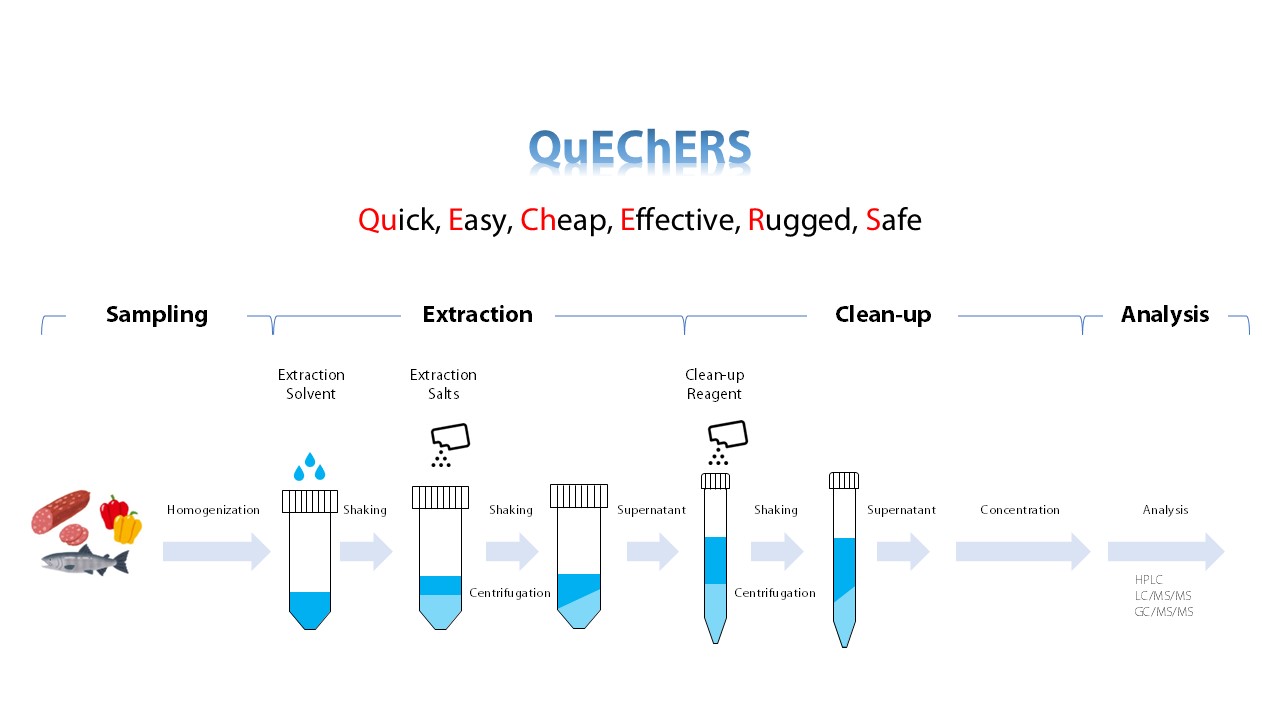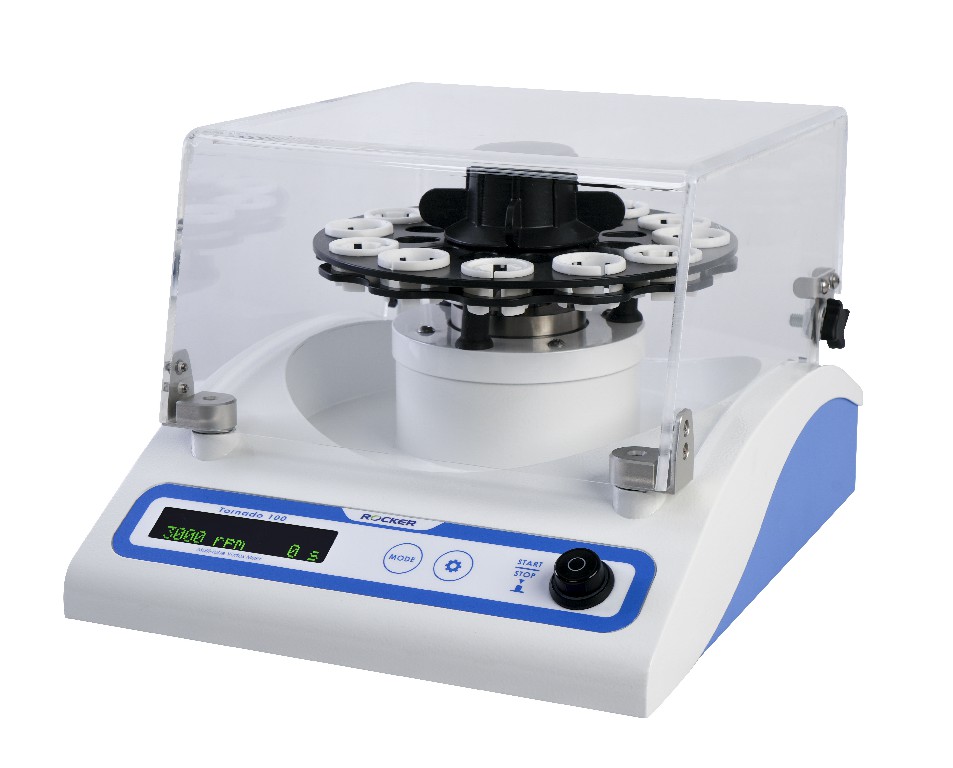QuEChERS: Optimizing Sample Preparation
In the field of chemical analysis, sample preparation is a critical step in the analytical workflow. Its primary goal is to effectively isolate target analytes from complex sample matrices, eliminate interfering substances, and concentrate the sample when necessary. This ensures the accuracy, sensitivity, and reproducibility of subsequent instrumental analysis. Sample preparation typically accounts for over 60% of the total analysis time, making its efficiency and effectiveness directly influential to analytical outcomes. When analyzing trace or ultra-trace levels of toxic substances, matrix effects become a significant factor affecting results. Therefore, optimizing sample preparation techniques is essential to overcoming these challenges.
Table of Contents
What is QuEChERS?
Principle and Workflow of QuEChERS
The Role of Shaking and Mixing in Extraction Efficiency: Why Choose a Tube Vortex Mixer?
Other Extraction Methods
Commonly Used QuEChERS Standards Worldwide
What is QuEChERS?
QuEChERS is an efficient sample preparation technique based on dispersive solid-phase extraction (dSPE). The name is an acronym that reflects its six core features: Quick, Easy, Cheap, Effective, Rugged, and Safe—pronounced like “catchers.” The method was first introduced at the European Pesticide Residue Workshop (EPRW) in 2002 and officially published in 2003.
The Six Core Features of QuEChERS:
- Quick: Sample preparation can usually be completed within 30–60 minutes, greatly reducing processing time. It is more than four times faster than traditional methods, significantly increasing lab throughput.
- Easy: The procedure is simple and intuitive, minimizing human error and lowering the required skill level of operators.
- Cheap: It drastically reduces the use of organic solvents and laboratory consumables—up to 95% lower material costs compared to traditional methods.
- Effective: Offers high recovery rates and effectively minimizes matrix effects, ensuring accurate analytical results.
- Rugged: Tolerant to minor variations in operating conditions, providing high stability and reproducibility.
- Safe: Reduced use of organic solvents and less waste generation lowers exposure risks for lab personnel and minimizes environmental impact.
Originally developed for pesticide residue analysis in fruits and vegetables, QuEChERS has proven to be highly versatile for extracting and purifying analytes from complex matrices due to its strong stability and broad applicability. As a result, it is now widely used to extract various analytes and contaminants such as animal drug residues, mycotoxins, polycyclic aromatic hydrocarbons (PAHs), polychlorinated biphenyls (PCBs), and polybrominated diphenyl ethers (PBDEs). QuEChERS has been adopted as a standardized method by international organizations such as AOAC International and the European Committee for Standardization (CEN), with notable examples including AOAC 2007.01 and EN 15662:2008.
Principle and Workflow of QuEChERS
QuEChERS combines liquid-liquid microextraction and the salting-out effect to transfer target analytes from the sample matrix into an organic solvent for extraction. This is followed by dispersive solid-phase extraction (d-SPE) to remove interfering substances, achieving efficient purification.

- Sampling and Pre-treatment: The sample is crushed and homogenized using a blender or homogenizer to increase surface area and enhance extraction efficiency.
- Extraction: An extraction solvent—typically acetonitrile—is added along with extraction salts. The mixture is vigorously shaken to transfer target analytes from the matrix into the organic phase. It is then subjected to high-speed centrifugation to separate the analytes into the supernatant.
- Clean-up: A clean-up sorbent is added to the supernatant, followed by further shaking and centrifugation. Interfering substances bind to the sorbent and precipitate out.
- Analysis: The purified supernatant can be concentrated and reconstituted before qualitative and quantitative analysis using advanced instruments such as HPLC, LC-MS/MS, or GC-MS/MS.
The Role of Shaking and Mixing in Extraction Efficiency: Why Choose a Tube Vortex Mixer?
In the QuEChERS method, thorough shaking and mixing of the sample with the extraction solvent and salts is a critical step to ensure efficient extraction of analytes from complex matrices. A tube vortex mixer offers several advantages, including:
- Enhanced Extraction Efficiency:
Intense shaking promotes the transfer of target molecules from the aqueous phase to the organic phase, maximizing extraction efficiency. - Improved Reproducibility and Reduced Human Error:
Hand-shaking can vary due to operator fatigue or differences in technique, which affects reproducibility. A vortex mixer ensures consistent and uniform shaking conditions across all samples, significantly improving the reliability of results. - Better Matrix Disruption and Mixing:
According to research by Oliveira, L. G., et al., using a ceramic homogenizer at this step enhances sample homogenization, increasing the reaction surface area. This is particularly beneficial for viscous samples or analytes encapsulated within cells. - Time and Labor Savings with Higher Throughput:
Manual shaking of large sample batches is time-consuming and labor-intensive. In contrast, a vortex mixer can process multiple samples simultaneously, boosting efficiency and throughput while significantly reducing manual workload.
| Tornado 100 Multi-Tube Vortex Mixer |
High Speed Dispersing | Hand Shaking | |
| Shaking Method | Innovative 3D Shaking | Vertical Up-and-Down Vibration | Manual Intense Shaking |
| Shaking Speed | Up to 3000 rpm | Up to 1750 rpm | Depends on Operator |
| Extraction Efficiency | High | High | Moderate |
| Reproducibility | High | High | Low |
| Throughput | Medium | High | Low |
| Labor Intensity | Low | Low | High |
| Safety | Yes, with Protective Lid | Yes, with Protective Lid | No |
| Weight | Medium (approx. 12 kg) | Heaviest (approx. 50 kg) | – |
| Dimensions | Medium | Large | – |
| Equipment Cost | Medium | High | – |
The table below presents the results of animal drug test from Laboratory P. Spiked recovery tests were performed using chicken as the sample matrix. Both the Tornado 100 and a traditional high-speed dispersing device were applied for sample preparation, followed by LC-MS/MS analysis to determine the spiked concentrations.
| Analyte Name | High-Speed Dispersing Recovery Rate (%) |
Tornado 100 Recovery Rate (%) |
RPDa (%) |
|
| 1 | Amoxicillin | 88 | 85 | 3.5 |
| 2 | Ampicillin | 91 | 87 | 4.5 |
| 3 | Cefalexin | 94 | 90 | 4.3 |
| 4 | Cefazolin | 86 | 88 | 2.3 |
| 5 | Cefotaxime | 89 | 97 | 8.6 |
| 6 | Cephapirin | 88 | 87 | 1.1 |
| 7 | Desacetyl cefapirin | 97 | 88 | 9.7 |
| 8 | Nafcillin | 86 | 84 | 2.4 |
| 9 | Penicillin V | 83 | 82 | 1.2 |
| 10 | Piperacillin | 91 | 98 | 7.4 |

The table shows that the Relative Percent Difference (RPD) between the Tornado 100 and the high-speed dispersing device is within ±10% for all analytes, indicating that the mixing performance of the Tornado 100 is comparable to that of the original equipment.
The QuEChERS Vortex Solution to Replace Manual Shaking

ROCKER Tornado 100 Multi-Tube Vortex Mixer
- Innovative 3D high-speed vortexing ensures thorough and uniform sample mixing
- Compatible with both 15 mL and 50 mL QuEChERS centrifuge tubes
- Dual operation modes (continuous/intermittent) for flexible use
- Saves up to 80% of space with no displacement issues
- Safety lid with auto-stop function—improves protection, prevents splashing, and enhances operational safety
Conventional sample preparation techniques include liquid-liquid extraction (LLE), solid-phase extraction (SPE), supercritical fluid extraction (SFE), solid-phase microextraction (SPME), and liquid-phase microextraction (LPME). Among these, LLE and SPE were the most commonly used methods for pesticide residue analysis—especially prior to the development of the QuEChERS technique. In the past, extracting target analytes from complex matrices often required combining two or more traditional methods, and sometimes integrating microwave or ultrasonic technologies to improve efficiency. However, such approaches were time-consuming, increased the risk of analyte loss, raised preparation costs, and reduced detection sensitivity—ultimately compromising the accuracy and precision of results. With the development and widespread adoption of the QuEChERS technique, it has increasingly replaced traditional methods not only in pesticide analysis but also in various other fields.
The table below outlines the differences between QuEChERS, liquid-liquid extraction (LLE), and solid-phase extraction (SPE):
| Method | QuEChERS | Liquid-Liquid Extraction (LLE) | Solid-Phase Extraction (SPE) |
| Solvent Usage | Very low | Moderate to high | Low |
| Extraction Time | Very fast | Slow | Moderate |
| Equipment Required | Centrifuge, vortex mixer, extraction tube, d-SPE tube (clean-up tube) |
Separatory funnel, vortex mixer | SPE cartridge, filtration manifold, positive/negative pressure device |
| Purification Efficiency | High | Average, requires additional clean-up | High with strong selectivity |
| Emulsion Formation | No | Yes, leads to poor recovery | No |
| Technical Difficulty | Low | High | Low |
| Automation | Possible | No, labor-intensive (manual shaking) | Possible |
| High Throughput | High | Moderate | High |
Learn More: Solid Phase Extraction
Commonly Used QuEChERS Standards Worldwide
To promote consistency in the application of QuEChERS across different laboratories, several representative international standard methods have been developed.
Below are two of the most widely adopted standards for food and pesticide residue analysis:
| Method | Method Number | |
| Pesticide Residues in Foods by Acetonitrile Extraction and Partitioning with Magnesium Sulfate | AOAC 2007.01 | |
| Foods of Plant Origin – Determination of Pesticide Residues Using GC-MS and/or LC-MS/MS Following Acetonitrile Extraction/Partitioning and Clean-up by Dispersive SPE – QuEChERS-method | EN 15662:2018 | |
Applications
- Food Analysis: Detection of pesticides and veterinary drugs in agricultural and livestock products; analysis of mycotoxins in food
- Biochemical Analysis: Analysis of antibiotics and veterinary drugs in biological tissues
- Environmental Analysis: Detection of organophosphates and organochlorines in water and soil samples
References
- A review of extraction, analytical and advanced methods for determination of pesticides in environment and foodstuffs, 2018
- QuEChERS – Fundamentals, relevant improvements, applications and future trends, 2019
- Vibrational extraction QuEChERS for analysis of antiparasitic agents in fish by liquid chromatography coupled with tandem mass spectrometry, 2019, Oliveira, L. G., et al.

